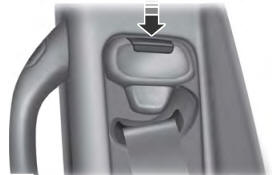Ford Explorer: Engine Cooling - 2.3L EcoBoost (201kW/273PS) / Removal and Installation - Coolant Pump
Special Tool(s) /
General Equipment
| Hose Clamp Remover/Installer |
Removal
NOTE:
Removal steps in this procedure may contain installation details.
-
Drain the cooling system.
Refer to: Engine Cooling System Draining, Vacuum Filling and Bleeding (303-03A Engine Cooling - 2.3L EcoBoost (201kW/273PS), General Procedures).
-
Remove the air cleaner.
Refer to: Air Cleaner (303-12A Intake Air Distribution and Filtering - 2.3L EcoBoost (201kW/273PS), Removal and Installation).
-
-
Detach the coolant hose retainers.
-
Release the clamps and disconnect the coolant hoses.
Use the General Equipment: Hose Clamp Remover/Installer
-
Remove the bolt and position the degas bottle aside.
-
Loosen the coolant pump pulley bolts.
-
IPTV Free Trial
NOTICE:
Do not pull the engine appearance cover forward or
sideways to remove. Failure to press straight upward on the underside of
the cover at the attachment points may result in damage to the cover or
engine components.
Remove the stud nuts and the engine appearance cover.
-
Remove the bolt (Enhanced Hexalobular or TORX PLUS ®
Acument Intellectual Properties, LLC as the owner) and the shield.
-
NOTE:
Make sure the accessory drive belt is positioned so coolant can not contaminate the belt.
Rotate the accessory drive belt tensioner counter clockwise and position the accessory drive belt.
-
NOTICE:
Cover the A/C belt to prevent coolant contamination of the belt.
Completely cover the A/C belt with waterproof plastic.
-
Remove the bolts and the coolant pump pulley.
-
Remove the bolts and the coolant pump.
-
Inspect the O-ring seal and replace if necessary.
Installation
-
Lubricate the O-ring seal with clean engine coolant.
Refer to: Specifications (303-03A Engine Cooling - 2.3L EcoBoost (201kW/273PS), Specifications).
-
NOTE:
Make sure that the mating faces are clean and free of foreign material.
Install the coolant pump and the bolts.
Torque:
93 lb.in (10.5 Nm)
-
Position the coolant pump pulley and install the bolts finger tight.
-
Remove the waterproof plastic from the A/C belt.
Install the accessory drive belt.
-
Install the shield and the bolt (Enhanced Hexalobular or
TORX PLUS ® Acument Intellectual Properties, LLC as the owner).
Torque:
18 lb.ft (25 Nm)
-
Install the engine appearance cover and the stud nuts.
Torque:
89 lb.in (10 Nm)
-
Tighten the coolant pump pulley bolts.
Torque:
177 lb.in (20 Nm)
-
-
Position the degas bottle and install the bolt.
Torque:
44 lb.in (5 Nm)
-
Connect the coolant hoses.
Use the General Equipment: Hose Clamp Remover/Installer
-
Attach the coolant hose retainers.
-
Install the air cleaner.
Refer to: Air Cleaner (303-12A Intake Air Distribution and Filtering - 2.3L EcoBoost (201kW/273PS), Removal and Installation).
-
Fill and bleed the cooling system.
Refer to: Engine Cooling System Draining, Vacuum Filling and Bleeding (303-03A Engine Cooling - 2.3L EcoBoost (201kW/273PS), General Procedures).
Special Tool(s) /
General Equipment
Hose Clamp Remover/Installer
Removal
WARNING:
Always allow the engine to cool before opening the cooling
system...
Special Tool(s) /
General Equipment
Hose Clamp Remover/Installer
Removal
Remove the air cleaner.
Refer to: Air Cleaner (303-12A Intake Air Distribution and Filtering - 2...
Other information:
Removal
WARNING:
Do not smoke, carry lighted tobacco or have an open flame of
any type when working on or near any fuel-related component. Highly
flammable mixtures may be present and may be ignited. Failure to follow
these instructions may result in serious personal injury...
Diagnostic Trouble Code (DTC) Chart
Diagnostics in this manual assume a certain skill level and knowledge of Ford-specific diagnostic practices. REFER to: Diagnostic Methods (100-00 General Information, Description and Operation).
Diagnostic Trouble Code Chart
Module
DTC
Description
Action
PCM
P0504:0..
Categories
WARNING: Position the seatbelt height adjuster so that the seatbelt rests
across the middle of your shoulder. Failure to adjust the seatbelt correctly could
reduce its effectiveness and increase the risk of injury in a crash.

read more
.jpg)
.jpg)
.jpg)
.jpg)
.jpg)
.jpg)
.jpg)
.jpg)
.jpg)
.jpg)
.jpg)
.jpg)
.jpg)
.jpg)
.jpg)
.jpg)
 Removal and Installation - Coolant Outlet Connector
Removal and Installation - Coolant Outlet Connector Removal and Installation - Cooling Fan Motor and Shroud
Removal and Installation - Cooling Fan Motor and Shroud
